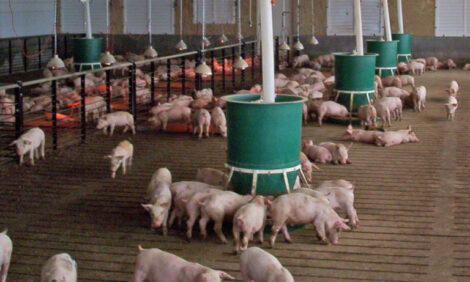



US Pork Outlook Report - February 2006
By U.S.D.A., Economic Research Service - This article is an extract from the February 2006: Livestock, Dairy and Poultry Outlook Report, highlighting Global Pork Industry data.
Hogs/Pork
The first month of 2006 presented a mixed picture for the U.S. pork and hog markets. Supply side signs were strongly positive in January, but in line with most expectations, while cautionary flags are beginning to emerge on the demand side.
Pork Supply Side Strongly Positive, Demand Side Less So
The first month of 2006 presented a mixed picture for U.S. pork and hog markets.
Supply side signs--estimated slaughter, dressed weights, pork production--were
strongly positive in January, but in line with most expectations. And while
cautionary flags are beginning to emerge on the demand side--domestic pork
demand in particular--foreign demand shows few signs of either relent or decline,
with USDA forecasting another year-over-year increase in U.S. pork exports, for
the 16th year in a row.
But despite beginning 2006 cold stocks at seasonal lows,
and packers handling anticipated weekly slaughters of 2 million-plus with nary a
whimper, markets appear increasingly focused on domestic demand, and on
questions of how higher costs of energy and loans will affect consumers’
willingness to buy pork products, at a time when attractively-priced poultry
abounds.
Some Background and Context for the Current Market Situation
The key market dynamic of the past 2 years has been the extraordinary jump in hog
prices that began in the first half of 2004 (See figure), and the subsequent price
reduction from August 2004 through January 2006.

While the figure indicates that hog prices have drifted slowly downward since summer 2004, most U.S. hog producers have enjoyed above break-even hog prices for the last 24 months. USDA’s 2006 hog price forecast--between $42 and $45 per cwt, for 51-52 percent lean, live equivalent hogs--anticipates above break-even prices for most producers this year. But there is some concern now that pork industry profitability may suffer if U.S. consumers, tired of high-protein diets, respond to higher energy prices and interest rates by reducing their consumption of pork products. This is a rational concern since 87 percent of U.S. pork production is consumed here at home, and commercial pork production in 2006 is expected to increase by more than 2 percent over last year.
Pork Production in January Estimated To Be Above a Year Ago, Wholesale Values Lower
The USDA Estimated Hog Slaughter Under Federal Inspection (FI) in January was
8.84 million head, or 2.1 million head per week, with estimated dressed weights at
204.5 pounds per head--almost 3 pounds above a year ago--and estimated FI
production of more than 1.8 billion pounds, more than 6 percent above January
2005. The increased production is consistent with USDA’s first-quarter
commercial pork production forecast of 5.24 billion pounds. Heavy January
dressed weights appear to be a result of ideal growing conditions--cool, not bonechilling
cold Corn Belt temperatures--rather than back-ups at slaughter plants.
Packers paid less for hogs in January. The live equivalent price of 51-52 percent
lean hogs was $41.37 per cwt, 22 percent below January 2005. First-quarter hog
prices are expected to average between $42 and $44, or about 17 percent lower than
a year ago. Packers are likely bidding hog prices lower, not only because of large
available producer supplies, but because prices at which they were able to sell pork
products are lower than last month and a year ago--a strong indication of softening
pork demand. The estimated wholesale value of the composite carcass--the
“cutout” was $61.50 per cwt in January, (see figure), more than 8 percent lower
than last month (December 2005), and almost 20 percent lower than a year earlier
(January 2005). (For updated information on USDA’s calculation of the cutout, see
http://www.ams.usda.gov/lsmnpubs/PDF_Daily/LS20060202ACPCO.pdf)
Subtracting the cost of hogs from estimated wholesale values of products yields an
estimate of the packers’ gross margin (see figure). From the figure, it is clear that
current packer margins are strongly positive--above both a year ago, and above the
3-year average of estimated gross margins. But estimated margins are currently
strong because hog prices are disproportionately lower, and not because wholesale
demand, as reflected in cut-out value, is higher. Again, the lower cut-out (see
figure) injects a cautionary note into an otherwise positive outlook picture.

2006 Retail Price Forecast Lowered Slightly
Fourth-quarter 2005 retail prices were $2.78 per pound, somewhat lower than expected. Prices may be lower due to some combination of increased retail pork supplies and consumers’ price sensitivities. USDA’s 2006 forecast for retail pork prices was lowered slightly to the mid-$2.70s per pound, from earlier estimates in the high $2.70s per pound. The slightly lower retail price forecast derives from expectations of higher 2006 retail supplies, and the effects that tight food budgets may have on consumer pork demand, when attractively priced poultry alternatives are readily available.
Links
For more information view the full Livestock, Dairy and Poultry Outlook - February 2006 (pdf)Source: Livestock, Dairy and Poultry Outlook - U.S. Department of Agriculture, Economic Research Service - February 2006








